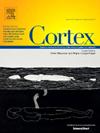Poststroke action slowing increases with task complexity and is linked to broader brain recruitment
IF 3.2
2区 心理学
Q1 BEHAVIORAL SCIENCES
引用次数: 0
Abstract
Despite its high prevalence, the mechanisms of slowing in stroke remain surprisingly poorly understood. Our objectives were (1) to determine the profile of slowing as a function of test complexity and (2) to examine the relationship between this complexity effect, test sensitivity and the recruitment of brain areas. The study focused on the 371 stroke patients and 581 controls of the GRECogVASC study assessed with eight time-limited tests: finger tapping, simple reaction time, line cancellation, Trail Making Test parts A and B, coding, and semantic and phonemic fluency tests. Action speed of patients was slower than that of controls (p = .0001); slowing worsened with test complexity (p = .0001) by 7.7% at each step of increasing complexity. The highest test sensitivity was observed (p = .0001) for more complex tests. The number of lesioned voxels associated with action speed increased with test complexity. The sensitivity of the tests roughly paralleled (p = .007) the volume of recruited brain areas. The individual slopes of action duration with test complexity correlated with the volume of lesion (p = .002), white matter hyperintensities (p = .0001) and parenchymal brain fraction (p = .0001). The effect of stroke on slowing is due both to small slowing on simple tests and to a general slowing of processing speed. The test sensitivity reflects the size of recruited brain network and its proportional vulnerability to lesion. In addition to their clinical implications, these results shed light on the organization of the systems that optimize action speed in humans.
中风后行动迟缓随着任务复杂性的增加而增加,并与更广泛的大脑招募有关
尽管它的发病率很高,但中风的减缓机制仍然令人惊讶地知之甚少。我们的目标是:(1)确定测试复杂性对慢化的影响;(2)检验这种复杂性效应、测试敏感性和大脑区域招募之间的关系。该研究集中在371名中风患者和581名对照者的GRECogVASC研究中,通过8项限时测试进行评估:手指敲击、简单反应时间、线条取消、轨迹制作测试A和B部分、编码以及语义和音位流畅性测试。患者的动作速度较对照组慢(p = 0.0001);随着测试复杂性的增加(p = 0.0001),每增加一步的复杂性,速度减慢会恶化7.7%。对于更复杂的测试,观察到最高的测试灵敏度(p = 0.0001)。与动作速度相关的损伤体素数随着测试复杂度的增加而增加。测试的灵敏度与招募的脑区体积大致相当(p = .007)。单个动作持续时间的斜率与病变体积(p = 0.002)、白质高信号(p = 0.0001)和脑实质部分(p = 0.0001)相关。冲程对减速的影响是由于简单测试中的小减速和处理速度的普遍减速。测试灵敏度反映了招募的脑网络的大小及其对病变的比例易损性。除了临床意义之外,这些结果还揭示了优化人类行动速度的系统组织。
本文章由计算机程序翻译,如有差异,请以英文原文为准。
求助全文
约1分钟内获得全文
求助全文
来源期刊

Cortex
医学-行为科学
CiteScore
7.00
自引率
5.60%
发文量
250
审稿时长
74 days
期刊介绍:
CORTEX is an international journal devoted to the study of cognition and of the relationship between the nervous system and mental processes, particularly as these are reflected in the behaviour of patients with acquired brain lesions, normal volunteers, children with typical and atypical development, and in the activation of brain regions and systems as recorded by functional neuroimaging techniques. It was founded in 1964 by Ennio De Renzi.
 求助内容:
求助内容: 应助结果提醒方式:
应助结果提醒方式:


